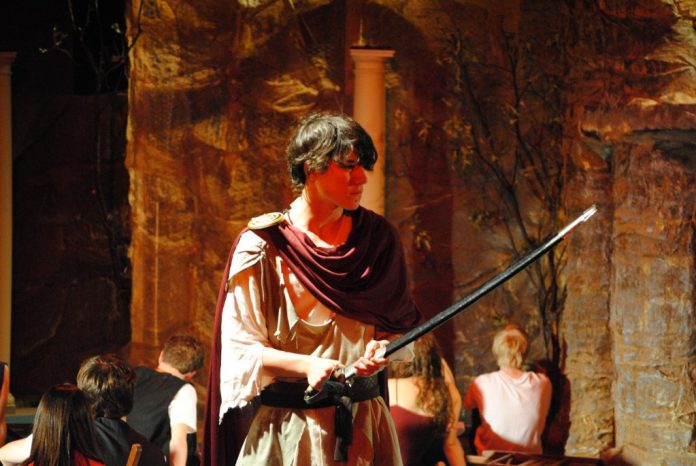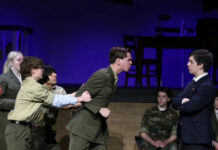November 18-20, the Jesuit theater season began with Mary Zimmerman’s adaptation of Homer’s The Odyssey. Like all Jesuit theater shows, it was filled with both technical merit and acting talent, thanks to the long hours worked by the thriving technical theater workers, led by Mr. Brooks Oliver, the dedicated actors, director, and assistant directors.
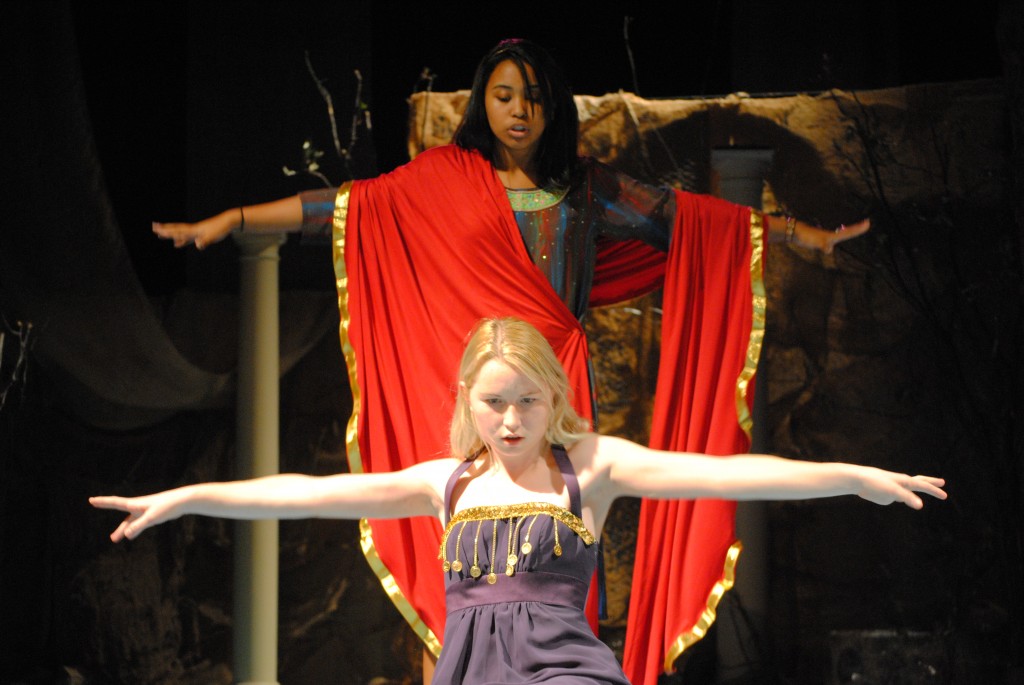 Over the past few years, the adaptation of classical works has been a trend in Jesuit Theater, transforming the ancient into a modern re-imagining that is relatable to the average Jesuit student. Shows like Metamorphoses, another Zimmerman adaptation, and The Burial at Thebes by Seamus Heaney, a modernization of Sophocles’ classic, Antigone, have rejuvenated old stories beyond the bore of classroom study, and this year’s production of The Odyssey is no different.
Over the past few years, the adaptation of classical works has been a trend in Jesuit Theater, transforming the ancient into a modern re-imagining that is relatable to the average Jesuit student. Shows like Metamorphoses, another Zimmerman adaptation, and The Burial at Thebes by Seamus Heaney, a modernization of Sophocles’ classic, Antigone, have rejuvenated old stories beyond the bore of classroom study, and this year’s production of The Odyssey is no different.
As a directorial concept, Mr. David Myers centered the play on a blending of classical and the modern, the original verse and adapted prose, an idea visible throughout the entire show in script, set, costuming, and scene concept. “We wanted to re-imagine the epic in a way that spoke to students and conveyed the meaning of Odysseus’s travels. In the end, the show was about telling a story,” Myers said. In the building of the set, columns of glue-hardened burlap were wrapped round chicken wire frames to create a classical allusion but also a textural uniqueness and modern flare. In the costuming, ancient drapery was used for classical characters like the Muse, Odysseus, and Telemachus,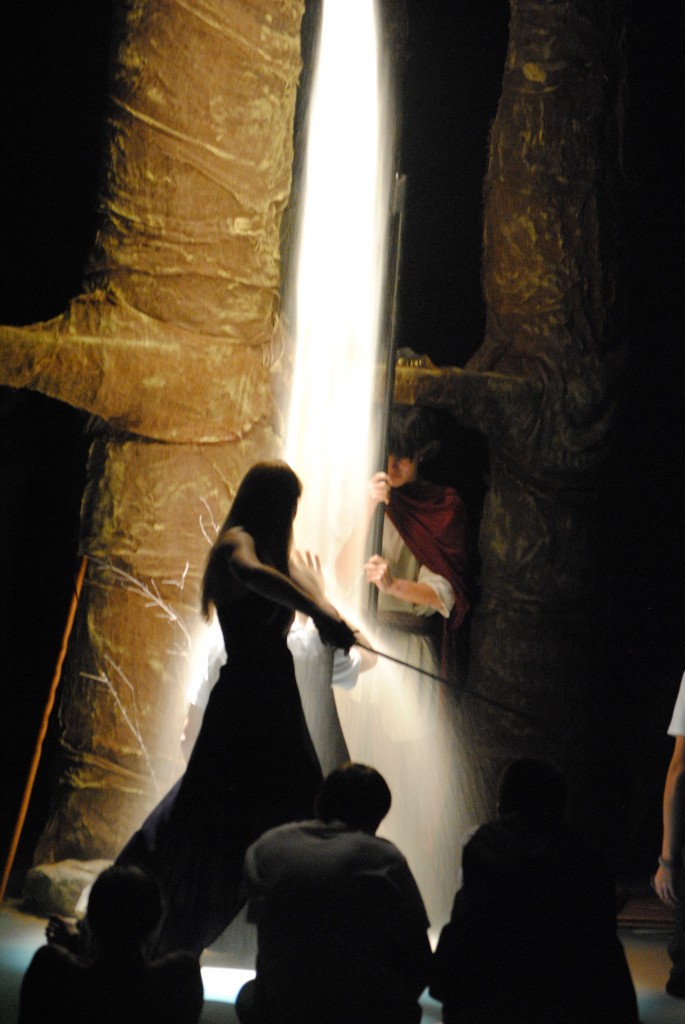 while Athena, played by Ursuline’s Maddie Ball, wore an evening gown and black leather boots and Circe, played by Maddie Weldon, wore a cheap and outdated prom dress. Even, Hermes sported a Jesuit biking uniform. These transformations brought both levity and humor, but also a relatable aspect to the show.
while Athena, played by Ursuline’s Maddie Ball, wore an evening gown and black leather boots and Circe, played by Maddie Weldon, wore a cheap and outdated prom dress. Even, Hermes sported a Jesuit biking uniform. These transformations brought both levity and humor, but also a relatable aspect to the show.
The biggest transformation of the story of The Odyssey was the tone. When I first think of the epic, the last thing that comes to mind is comedy, but that became the direction of many scenes. The show dipped between emotional scenes and scenes that brought some comic relief. In many ways, the show begged for hints of absurdity and humor. Like me, Jeffrey Artigues, a Jesuit senior who also photographed the show, remarked that he “would normally balk at the mentioning of Homer’s The Odyssey, that dreaded tome from freshman English … [Jesuit Theater] successfully streamlined the novel’s complex storyline that many struggled to follow, with just enough hilarity mixed in to capture the attention of its high school audience while still retaining the plot.” How else can you portray a scene with a towering Cyclops? It’s not easy and comedy seemed to be the best answer. And the actors handled it beautifully; Frankie Guidone and Dylan Stone, the two actors who played the Cyclops, Polyphemus, one on the shoulders of the other, brought the scene to life, interpreting the character as a shallow, back-country farmer with a slight accent, choreographing movements to create a cohesive body that towered on the stage. Add a few G.I. Joe action figures swallowed by the beast and the audience erupts in laughter. Reworking the Odyssey made it more accessible to the actors. Durgan Koch, who played Alcinous, reflected that his scene “became very conceptual, as others did, and an emphasis was brought to the words of the story. This emphasis may not have been there, or the story at least would have been less comprehensible, if the play had been very traditional.” By lightening the mood of the show, the story was allowed to shine through, the creativity of the cast and crew could flourish, and both audience and actor could enjoy the performance.
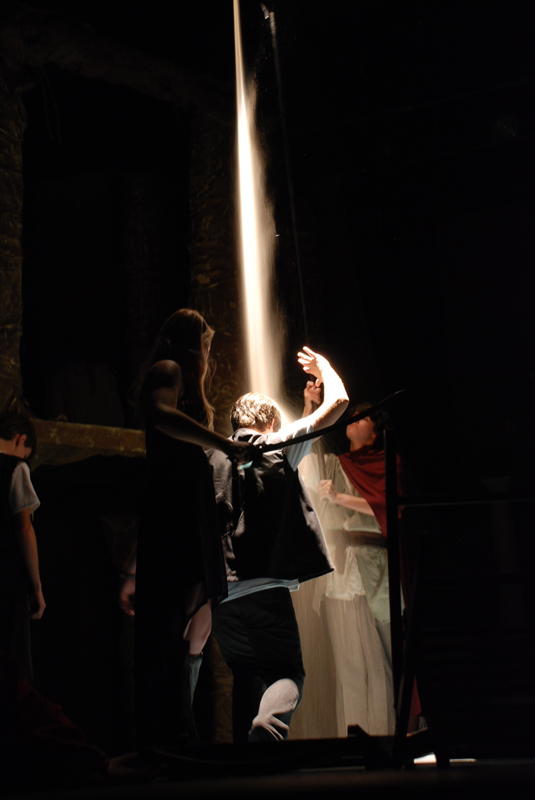 In many ways, this show was a milestone for Jesuit Theater. Over the years, marketing of shows has become easier with the influx of media outlets like Facebook and YouTube. The whole of the student body and their friends can readily be informed and audiences increase. The Odyssey marked Jesuit Theater’s first use of YouTube as a marketing outlet. The promotional video allowed for students, faculty, and parents to preview the show and spread the word about Jesuit Theater. Maddie Weldon, who played Circe, said that “the promo video even got Ursuline students aware of the production.” And the effects showed; both Thursday and Friday shows sold out, people lined the aisles, and some were unfortunately turned away at the door, proof of the effective promotion for the show. Maddie added that these audiences “reacted differently each night. Each full house led to fun and slightly rambunctious performance. The dynamics of live performance really made every night feel like an opening night. All I needed to do was have fun!”
In many ways, this show was a milestone for Jesuit Theater. Over the years, marketing of shows has become easier with the influx of media outlets like Facebook and YouTube. The whole of the student body and their friends can readily be informed and audiences increase. The Odyssey marked Jesuit Theater’s first use of YouTube as a marketing outlet. The promotional video allowed for students, faculty, and parents to preview the show and spread the word about Jesuit Theater. Maddie Weldon, who played Circe, said that “the promo video even got Ursuline students aware of the production.” And the effects showed; both Thursday and Friday shows sold out, people lined the aisles, and some were unfortunately turned away at the door, proof of the effective promotion for the show. Maddie added that these audiences “reacted differently each night. Each full house led to fun and slightly rambunctious performance. The dynamics of live performance really made every night feel like an opening night. All I needed to do was have fun!”
But the most interesting aspect of the show was the cast. As a student and assistant director, I have rarely worked with so many new actors; a large majority of the cast members were either freshmen or sophomores experiencing their very first stage performances. Often, directors will shy away from such a young and inexperienced cast, but Mr. Myers is committed to introducing new talent and the expansion of Jesuit Theater in the school community. A fresh talent base promotes a thriving arts community for the future. As a student director, I was surprised by the cast’s willingness to expand horizons and try new things, especially Alex Venegas, a Jesuit sophomore who played Odysseus. This was one of Alex’s first performance experiences; he brought a dedication and enthusiasm to learn all he could and to perform to the best of his ability. From memorization to emotional recall, each week a milestone was passed and it was wonderful to watch cast members grow as actors. Reworking the Odyssey made it more accessible to the actors. My scene became very conceptual, as many others did, and an emphasis was brought to the words of the story. This emphasis may not have been there, or the story at least would have been less comprehensible if the play had been very traditional.
Overall, The Odyssey was about telling a story, enlivening an ancient epic into a new and relatable tale that an audience could enjoy watching. The tale of Odysseus became a thrilling example of modern theater bringing new flair to classic literature.
The Odyssey cast featured Jesuit students Alex Venegas ’13, Frankie Guidone ’12, Joe Kaplan ’11, Colin Traver ’13, Chase Scott ’11, Durgan Koch ’12, Luc Johnson ’11, Noah Barron ’12, Tom Andrews ’11, Dylan Stone ’12, Ryan Diller ’13, Griffin Miller ’13, and Denis Alexander ’14, and Ursuline students Maddie Ball, Alex Stuart, Kristen Portner, Maddie Weldon, Jessica Long, Grace Cunnigham, Imani Youngblood, Adrian Collins, McKenna Wierman, and Rose Mannas. Assistant directors were Connor Capetillo ’11 and Ian Stack ’11. Faculty were Mr. David Myers, Ms. PatriciaWatson, and Mr. Brooks Oliver. Mrs. Miki Melsheimer helped with costumes.
Congratulations to the entire cast on a wonderful production!
Photography by Connor Capetillo, Mrs. Miki Melsheimer, Mark Ross


